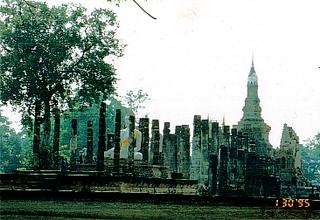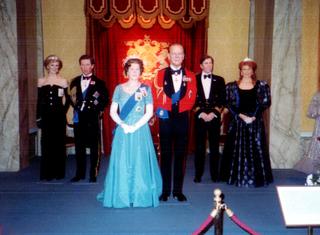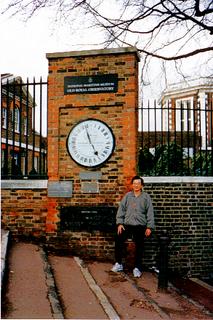Author’s note: I sent this article to Harvard Business Review. Lately, there was a change by the SEC urging FASB to adopt principle-based approach with conceptual Framework in the formulation process in mind.
Principles based or rules based? For a start, I want to relate an indelible experience to you.
About sixteen years ago, I worked as underling in an international accounting firm. The firm conducted weekend in-house training. I was grouped into advanced level training group due to my good professional exam results in accounting theory. Certainly, I also became a target to denigrate due to internal competition among different audit groups.
In a class training for Accounting for leases, an Australia trained manageress of another audit group picked me to answer the question of what serve the purpose for accounting for leases. I uttered tenaciously, "Substance over form". She derided me like I am ignoramus. It fermented the whole class break into laughter as if I was a moron giving such blather. I squirmed and suffer ostracism. Only two of my colleagues taking the same examination conceded my answer to me after class. The kernel of truth is: for finance lease, the lessee has to take asset into account if the lessee enjoys substantial risks and rewards of the asset. You cannot throw away the substance that the lessee is the owner of the asset albeit the form, a lease is not an outright purchase.
This experience coupled with my own observation debunk the fact that many standard users are enamoured with "tell me what to do than tell me what to think", many see the conundrum is on the usage, such as how to apply present value to minimum lease payments, rather than a methodical framework towards linking accounting principle with the application; Even though literally many leases are finance lease in nature
Many UK accounting professionals pride themselves on the UK GAAPs are principles based and therefore are superior. They perceive the lethal blow for rules-based accounting is it cannot cover every possibility, and easily give opportunities for perpetrator to game the system. It is evidenced fifteen years ago; my Advanced Financial Accounting lecturer is an ardent critic of rule-based accounting. I was then a novice in accounting, only familiar with UK GAAPs and IAS. I did not have the faintest idea about US GAAP. I guessed he might be intransigent. I remained oblivious and promiscuously refer to US published accounting textbook for details on fundamental accounting principles and conceptual framework of accounting when I sat for professional exam paper- Regulatory framework of accounting, and surprisingly I scored well. It showed that using US textbook; I did not appear as heretical, at least not incriminated in the eye of UK examiner.
I perennially held this neutral stance after qualification; I was more malleable as I had more opportunities in contact with US GAAPs. I wanted to know what the quintessence of US GAAPs was. I read an US accounting periodical "Accounting Horizons"; there was an article on the concept of assets in accounting theory. The article referred the definition of asset to the conceptual framework of FASB. It shows that any standard setting process cannot do without referring to conceptual framework whether it is UK or US GAAPs. So, what makes a standard efficacious? In an UK accounting journal, an article compared US accounting standards with IFRS accounting standards; quoted US GAAPs are rule-based standards with more specific application guidance. And IFRS are principle-based standards with limited application guidance. An US accounting magazine said, Concept based standards are considered to be superior to rule-based standards, Accounting result from applying a concept is usually more understandable and apparent than the result of applying a rule. Rules generally are more interpretation than concept.
It was said litigation abounds in the US, small wonder that the American prefers explicit rules than broad and nebulous principles. According to a well-written book- "Profits you can trust", the authors recount the history of US standard setting, "Until the 1970s, in fact, the accounting standards setting process in the United States was largely principles based. But almost imperceptibly, the operating philosophy of financial reporting began to change, as capital and commercial market transactions evolved in ways not anticipated in the GAAP established in earlier, simpler times." "The business environment in the United States became increasingly litigious. Not only were companies looking for accounting solutions to increasingly complex transactions, they also wanted cover in case they had to defend themselves against shareholder lawsuits. What they wanted, quite simply, was detailed guidance on how to implement GAAP-something that would go beyond basic principles and provide concrete, practical rules for accounting for complex transactions, reliance on which would allow them to prevail in court. Hence the birth of rules-based accounting."
The authors see this produced two consequences, "the complexity of US GAAP increased immensely, mainly because of the exponential increase in the amount of interpretation by the FASB, the chief guardian and promulgator of GAAP, and other professional bodies such as AICPA, second, much of the guidance that poured forth from the FASB and elsewhere came at the express request of corporations. When companies intervene in the rulemaking process, it’s usually because they want something from it, and what they want may not be in the best interest of investors and the public. Not only are corporation looking for guidance they can point to in the event of litigation, they also seek solutions that promote their own financial objectives." "The result: GAAP is riddled with scores of exceptions to the rules. Exceptions often arise as compromises between the demands of investors and the practical implementation concerns of public accountants and corporate manager."
Rules-based supporter contended," IAS cannot prevent misleading comparisons any more than it can stop corporate managers bend on fraud. The system’s broad principles are subject to a wide range of interpretation, not only from one country to another and one firm to another, but even within different offices of the same firm. With so much room for interpretation among practitioners, compatibility across companies is routinely compromised. One Big Four accounting firm, concluding that existing interpretations of IAS were too broad and vague, developed a handbook spelling out the firm’s official interpretation of the standards. At another Big Four firm, the merger of two client companies sparked a row between the firm’s London and Paris offices, with clashed over interpretation of several IAS principles relating to mergers."
An article in Accounting Horizon gave accolade to principles based, saying "Standards that are concept-based are not as susceptible to manipulation and abuse than rules based. Although conceptual guidance requires judgment in defining the concept that, in turn, provides the potential for misapplication, the economic rationale embraced by the concept serves to limit the extent to which it can be misapplied. Rules preclude the use of judgment, and thereby reduce the possibility for misapplication. However, they have the potential to be abused through careful structure of transactions to take advantage of the rule.
So which side to espouse without predilection, more specific application or limited application? As the business world increasingly more complex, it behoves the accounting standard setter to keep standards more detail or simple? Will moving to principles-based accounting stultify perpetrators’ efforts and make them less scope to manoeuvre? What accounting frameworks we should adopt to resolve business complexity? How about the political culture aspect in the standard setting process? Should country standard setters preserve their peculiarity or move towards harmony? It is a challenge facing principles-based IAS setters. For standard setter, how to achieve greater results with financial constraints? These are problems in the standards setting process. This article is to provide a new perspective on standard setting process than join in the fray on whether standards should be principles or rules based.
We first define what are standards? The dictionary defines standard as something considered by an authority or by general consent as a basis of comparison, a rule or principle that is used as a basis for judgment. According to this definition, in a broader sense, rule, principle and standard can be used interchangeably.
In the US, AU411 gives definition to GAAP as a term encompasses the conventions; rules and procedures necessary to define accepted accounting practice at a particular time. It includes not only broad guidelines of general application, but also detailed practices and procedures. Those conventions, rules and procedures provide a standard by which to measure financial presentation. As to conceptual framework, FASB defines conceptual framework as a constitution, a coherent system of interrelated objectives and fundamentals that can lead to consistent standards and that prescribe the nature, function and limits of financial accounting and statements. In the US, the FASB had issued 6 concepts statements and 150 standards; concepts are intended to guide the development of accounting standards. In the UK, a similar conceptual framework Statement of principles was issued in1999, the content of which is largely similar to SFAC1 (Standard of financial accounting concept) to SFAC6 (Concept 3 becomes part of concept 6).
In the US, FASB (under which is emerging issues task force)(EITF) and AICPA are the major standard setting bodies Accounting principle application is dependent on the hierarchy of GAAP by an authoritative body and other relevant sources. Category A is officially established accounting principle consists of FASB statement of Financial Accounting Standards and Interpretations, Accounting principle Board opinions, and AICPA accounting Research Bulletins. Compliance is mandatory for Category A. Category B Consists of FASB Technical Bulletins and, if cleared by the FASB, AICPA Industry audit and Accounting Guides and AICPA statement of position. There are also Category C & D issued by AICPA and cleared by FASB.The general rule is to use treatment specifies by the source in the highest category. If an accounting treatment is not specified by category A, an accounting pronouncement in category B, C, D is relevant to the circumstances, an auditor must follow that pronouncement or be able to justify the conclusion that another treatment is generally accepted.
In the UK, Accounting Standard committee (ASC) is charged to review standards of financial accounting and reporting, publish consultative documents with the object of maintaining and advancing accounting standards, to propose to the councils of the governing bodies statements of standard accounting practice and to consult as appropriate with representatives of finance, commerce, industries and government and other persons concerned with financial reporting. In 1987, Dearing Report resulted a new standard setting organisation; i.e. Financial Reporting council (FRC) in charge of Accounting Standard board (ASB) (ASB also in charge of Urgent issues task force) and Financial Reporting Review panel.
The biggest difference between UK and US is the enforcement of the standard, in US the enforcement of the standards is by SEC, the accounting rules it publishes in SEC SX have the force of law, and SEC relies on rules issued by FASB. Whereas in the UK, the compliance with SSAPs depends on individual professional bodies internal disciplinary procedures. In UK stance, it is towards self-regulation. The Company Act 1989 introduced a new form of legal backing for accounting standards.
To avoid badgering in the fray of UK principles-based and US rules-based, we ask ourselves what constitute a quality accounting standard setting process? It is palpable that the choice will be conceptual framework. Conceptual framework is often adopted in a standard to serve as a basis for depicting transaction under the scope of the proposal. It is also used to decrease the confusion that may result from allowing the accounting to be based on a selection of any of the competing economic views.. The exact contents in SFACs (US) and Statement of principles (UK) are almost the same and are not enigmatic, such as materiality, understandability that people have little impugn of their general importance. The quintessence in the conceptual framework I use as yardsticks for measurement is the quality of accounting.
After scouring through important key quality characteristics, they are culled, and the eventual key criteria are almost the same with quality of accounting apart from I give slightly different meanings. I proffer the reasons for using particular measures. In the following, I enumerate key critical criteria: relevancy (serving the need of the users as a whole, reflecting the current economic reality.), consistency (to give confident to the users that the same principle applies across the board), objectivity (not to please a group of people at the expense of another.), reliability (the trust element and transparency and veracity), economy (the resources usage towards its outcome), comparability (to aid user making meaningful decision despite geographical dispersion, cultural diversity or different businesses.), accuracy (mainly on how to deal with uncertainty, concerning judgment and estimation) A comparison of my construction with the official definition is made in the note at the end of the article; you can totally disagree with my selection but make sure your selection is congruous.
In the US, quality of accounting also includes conservativism, neutrality and verifiability. Conservativism is good virtue. Many CPAs learn this basic accounting convention in the principle standard. Majority of the accountants are conservative. Conservativism has major pitfall, which is being manipulated to create hidden reserves as what many accounting critics view many German companies are doing in their accounts. Keeping hidden reserves do not depict the economic reality of the organisation activities (contradict to relevant, and undermine the trust element, reliability). Therefore, conservatism is a double-edge sword. We have conservative proclivity we need to trade-off by looking into relevancy and other preset criteria. Verifiability, historical accounts are generally verifiable. However, owing to rapid change in the business environment, the increasingly use of personal judgments and estimations, in many instance, we encounter many incidents that items are not easily verifiable. I incorporate this in accuracy in the evaluation criteria above, and will deal with in detail below. Neutrality has some element of objectivity.
. "It is better to be approximately right than precisely wrong."
It is matter-of-fact that Financial Statements are hard to achieve absolute accuracy, because there are many line items require professional judgment. We have to recognise there is more judgment and less precision in accounting especially in the knowledge-based economy. In no small measure, judgment always goes hand in hand with materiality. Materiality is part of the conceptual framework, is relative in a sense; therefore accuracy is also relative.
"If the accuracy of the answer is itself inherently uncertain, what does a very long and seemingly precise number mean?"
It is prevalent in this turbulent business world, we have to deal with uncertainty in decision-making, in the Financial Statements or Annual Report, and we are forced to make judgment. The perennial problems are management made wrong judgment about the uncertain future; auditor relied on wrong management forecast and prediction. No one can make uncannily accurate prediction of the future presciently; neither can we shirk our responsibities projecting future ahead. Standard setter can do very little besides issuing guidance. Generally, there are three approaches to deal with uncertainty. First, judgment can be based on historical experience; it is intrinsically human nature to predict future based on past experience. This assumption is flaw. In the fast changing world, the future may not exactly mimic the past.
Second, is the use of heuristic (other similar terms like gut feeling or hunch) approach, sometimes it does work. Some users may see it visceral and therefore preposterous, as if a punter. These users question, "Do you always strike it right all the times?" The third approach is golf pole approach. We break the long uncertain future into shorter time frame to make incremental measurement. In the golf field, no one cannot see all golf poles in the field in a glance, and we focus on those visible. Auditor can document management judgment unequivocally according to visible golf pole and gradually gain confidence and assurance.
Of course, we can capture many others quality characteristics to consummate the criteria; such as matching, a commonly used principle in accounting convention; issue like share options, the cogent reason is to match the compensation incurred with the incentive to motivate employee to enhance share value by generating more revenue or reducing costs in the period. Another commonly used criterion is materiality, one of the elements of qualitative characteristics. It is without saying that all standards are dealing with material issues. SAB no 99 provide guidance for registrants and auditors on evaluating the materiality of misstatements in financial reporting and audit processes by summarising certain GAAP and federal securities laws as they relate to materiality. Here we only focus some practically useful key criteria. Research shows relevancy is the most important among all. Even within these criteria, we can rank different degree of importance for evaluation. The standard setter should rank their priority to facilitate trade-off in the evaluation of standards. In other word, standard setting authority should set level of importance for these criteria according to the balance between user preference and responsibility as standard setter. For example, in the US, the standard setter yielded to the lobbyists’ political pressures, making exceptions to the promulgated standards. That literally undermines consistency (defeating user confidence of the authority of the standards). The crux of threading the fine line between flexibility and authority and to balance user preference and standard setter own responsibility is to evaluate the countervailing factor based on preset criteria, because preset criteria align with the purpose of the standard.
Having set the qualitative criteria, we proceed to take a closer look of the process of standards setting. Those like to know the US and UK standards setting process can refer to note at the end of the article. My ideal structure and process are to streamline the standard setting process, breaking ossification and arcane old rules, and adroit handling of project management. The structure should facilitate division of duties, also collaboration The objectives are to make flow of information and coordination simpler, avoid remiss, elude responsibility and mutual recrimination; The upper tier is the board; middle tier is working on the gestation of accounting principles and application. The lowest tier is quality-checker by liasing with users and "standard hackers".
We begin the process by defining the problem. First, we look through the lens of accounting from the business context (I exclude non-profit making, as they can mimic business model for solution.). Accounting is to reflect the business context, for example, Accounting for Intangible assets is to address the value creation in the knowledge-based economy. Increasing financial risk due to global trade and investments was reflecting in the changes of exchange rate and hedging activities. Intense competition leading to corporate restructuring, merger & acquisition, lop off non-core assets resulting business combination and disposal. If we used to see the standards as piecemeal, we cannot link accounting to the bigger business picture, we may fail to reflect accurately the economic reality and we are behind the fast changing business world, and always. The outcome also contravenes to our first quality rule-relevance.
The first tier Board level should ideally be full time technical pundit. Rather than be rubber stamp, the board need to change the reactive attitude and working style to proactive by continually assessing current accounting standards and the needs of business environment to find the gap. Of course, the board will continue to elicit feedback from outsiders on potential issues. After deciding on issues to pursue, the board’s meeting will prioritise the project to work on under the resources constraint. First and foremost, a detailed analysis of project at hand must be deliberated to ensure choosing the right project, and not wasting unnecessary resources.
The first step is to verify the business context to make sure the accounting issue is accurately reflecting business context, and the result is to yield an in depth understanding of the issue. What the users look for? How a new standard will resolve their problem? Get to know the practical aspects of application of the standard. There are some caveat for getting external feedback, it is time consuming and the response depends on topic discussed; usually it is hard to get enough responses or the responses may not dovetail the board wants. The board has to deliberately draft critical issues to be resolved, so that critical information is not left out in the survey, and the findings will be directional. On the other hand, ideas are also mooted from volitional choice or diatribes to balance the focus. This step the board collaborates with third tier quality checker. The checker is to execute the job, evaluate the results and submit the findings to the board. They should carefully choose whom to approach to get a reasonable user representation and maintaining contact with them for further assessment of exposure draft.
Under the present system, there are interminable rounds of public comments, hearings and advisory group meeting. It therefore calls for the structure to facilitate coordination and collaboration and the board to have good communication and project management skills. Ultimately, it is to achieve one of our criteria-economy, on the back of efficiency and effectiveness.
The second tier is to execute the project; it requires a team of technical competent staff to work together. At least a board member is leading the team on a project. It begins with building conceptual framework for the accounting issue. I am puzzled there is no special section in the standard for accounting principles. I think ignoring its significance is at the peril of the users whether in dispute or litigation. The leader briefs the team on the project chosen, the purpose, the business context underlying the project and the findings from the business context survey.
Ideally, the standard setting team should have a share database storing or indexing research articles, publications, pundits’ view on the relevant topic, and field search results after talking to auditors, CFOs, and academia and the address book of all the targeted contacts. The team will then link up every piece collected to form an initial understanding of the project.
The team then meet or net chat with no scruple to brainstorm reams and reams of concepts relevant to the current accounting issue. The team sifts through all the concepts, grouping the concepts into core, adjacent concepts, and irrelevant concepts. We can split core concept into general core and specific core. This step of drawing up concept map is important; the subsequent application must be able to prove the link to any of the core or adjacent concepts.
I illustrate this step by using accounting issue revenue recognition as an example. I discover that UK amendment to FRS5 has included basic principles that reflect the statement of principles, i.e. the conceptual framework. I wish to see the same topic from a different perspective. Hope my focus on key criteria will provide sharper teeth to bite while in dispute and litigation. Supposing the team begins to brainstorm by raising several of the concepts, such as matching (matching the revenue with the period it generated, matching revenue against the cost incurred), risks and rewards transferred (Goods has been delivered to the recipient in good condition), Performance (Goods are delivered or service is done to the satisfaction of the recipient), prudent (no ambiguity of collection, no recognition of revenue until collection is certain), legal title has been or is being transferred, ownership, fair value of revenue collection, and prevailing interest rate as cost of capital, contractual agreement.
After the team propounded all the concepts they think relevant to the accounting issue. The team is to draw distinctions among the concepts. Core is the centre, the most important part of the principle. General core are affecting all, not specialised or limited to a range of use. Certainly, Matching, prudent are general core concepts. Specific core is tailored to the topic at hand. Risks and rewards transferred, ownership, and legal title passed are the same thing in different terms. They are specific core, performance is done, collection must be certain, are all specific core. Adjacent concept is not core but relevant to topic discussed. Contractual agreement and fair value of collection at prevailing interest rate are adjacent concept. The team then concludes a concepts map specifies general core, specific core and adjacent concepts in the map. That forms the structure of accounting principles.
The team then continues with the real life applications to challenge the concept and also draw up specific guidance. No matter how the business environment changes, the conceptual framework (the accounting principles) must be able to withstand the changes. How detail should the application guidance be? Guidance is guidance. You cannot go into very specific and eventually casting more doubts when there are slight differences with the guidance. How broad should the guidance cover? The answer is as broad as possible. There is an unsung quality of standard setting process that is fairness. When the standard is ambiguous, there are grounds for contentions. Especially, the contentions fall in the grey area. The standard setter has to be specific. The guidance should be indexed for easily reference. Whether they are indexed for the purpose of consignment, software revenue recognition, long-term construction contract, or Telecommunication industry. The crux is how the application is linked to the conceptual framework? The application for revenue recognition can be indexed industry-based. Adjacent industry can be grouped to use same application.
The team proceeds to challenge the application formulated. I draw some of the examples from "Profits you can trust" to see how solid the conceptual framework is?
Sunbeam case –the authors named the accounting game as "channel stuffing" whereby "a company stuffs its distribution channels with merchandise, which it then claims to have sold". Goods under consignment or subject to return are under this category. If we examine accounting principles, ownership concept is relevant; the risk and rewards have not been transferred from the sellers to the buyers.
Software companies-the authors used "grossing up" to describe "a software company treat a ten-year agreement to provide e-business support to a client that is burning through million of dollars a quarter and has no product on the market, many software companies treated such agreements as sure things and booked the revenue as if ten years’ contract payments had already been collected" Clearly, matching, prudent and performance are relevant here, Contract agreement is only adjacent concept whereas matching (Match periodic payments received with the cost incurred) prudent (collection is uncertain) and performance( service has not done) are core.
Dell case-It is interesting due to supply chain complications. Especially many companies outsource their non-core processes. That is why I stress in the beginning of this article that to stay relevant, we need to look closely to business context. The authors posed this interesting case, "Supposing Dell corporation sells, as a component of one of its PC, a computer monitor it purchased from an independent manufacturer. Does it recognise as revenue only its gross profit margin-the difference between what it pays for the monitor and what it charges its customer? Or does it recognise the complete PC as revenue, treating the cost of the monitor as an expense" The authors offered this answer, "In such a case, Dell recognises the full price of the monitor, and rightly so" The underlying principle is Dell takeover the risks and rewards of the monitors from its suppliers and sells the monitor to its customer. It is completely different from commission-earned case whereby the commission earner is not exposed to the risk of carrying goods. The ownership concept is relevant here. The authors then add some complexity into the case by saying that "But what if Dell were to arrange –as it often does –for the monitor to be shipped directly from the manufacturer to the customer? Should Dell include the monitor’s selling price in its revenue, or only Dell’s cut? In other words, should Dell’s sales figures suffer just because of an efficient logistics arrangement?"
The answer is the same, because Dell is responsible any damage in the delivery process till customer’s acceptance. The ownership has not changed until it is transferred.
4. Xerox case-"Xerox leases business machine such as copiers and printers to customers for extended periods, it treats the lease as a sale. It books the value of the lease all at once as revenue, even though payments on the machine may extend several years into the future." "The revenue booked is equal to the present value of future lease payments." Now the trick here is what discount rate you use to derive present value. Xerox Mexican subsidiary used a rate much lower than the prevailing interest rate just to inflate present value of its revenue. Assuming that the lease treated as sales is correct permitted in US accounting rules. The adjacent concept of fair value was manipulated by using lower discount rate to inflate revenue.
5.Global Crossing-Global Crossing involved in swapping capacity with competitors they all not wanted just to book revenue and capitalised capacity purchased from competitors to inflate revenue. SEC ruled fiber-optic swaps invalid in 2002.There are no controversy of what accounting principles should apply here, just outrageous earning manipulation.
The team has gone through the challenges for principles and application to ensure that at least the principles are complete and ready for exposure draft. The exposure draft is measured according to the preset quality criteria-relevancy, consistency, reliability, objectivity, and comparability. If they are satisfied, they will handover the draft to tier three for quality-check.
Tier three is to keep close contact with external users and forms a group of professional standard hackers as devil's advocate to find the loopholes in the draft. The board will decide uncompromising quality standard by adopting six-sigma to run the gamut of the project or adopting a decimated statistical control approach on exposure draft. The former uses DMAIC (define measure, analyse, improve, control) to maintain project quality, improve speed, and keeping a lean structure.
Not any Tom, Dick and Harry can be a professional standard hacker. If they can hit the core, they are ace hacker. Will be given a token reward and their findings will be published in leading accounting journal. If the ace hackers consecutively hit the core three times, he should be invited to the board. They play the role of counteraction. It is easy to find omission in application but not easy to finds any omission in principle searching as the technical team has gone through rigorous searches and tests.
The third tier will survey business context, and report on the findings to the board at the initial stage. They will keep close touch with the second tier in the setting process for special issues required further survey at the second stage, and at final stage, they issue survey form co-drafted by the team and the board to elicit feedback on exposure draft, evaluate the results to determine the quality of the exposure draft and conclude their findings for the board further actions. The board will base on the quality report to decide to go ahead or make amendments to the draft. There will be no further enquiry and go straight to the final stage promulgation. Third tier will be doing the legwork on final promulgation of standard. After promulgation, third tier checkers have to follow up the field practice on new standard for six months to sense the real test of the standards and document the feedback in record for future amendment.
In the close, I have answered many of the questions raised in this article. As to will moving to principles-based accounting make perpetrator less scope to manoeuvre? No accounting Standards will stop the perpetrator, but the perpetrator will find it hard at their will to link the accounting principles to their application. Should country standard setters preserve their endemic peculiarity or move towards harmony? How about the political culture aspect consideration in the standard setting process? It all depends on who the users are and their purpose of using the Financial Statements. A good standard setter appears to be neutral to political culture. If the users are geographically diverse, comparability may be ranking high on the card.
Notes:
Note1: Statement of conceptual framework includes the followings:
Relevancy- Concept statement uses predictive value and confirmatory value or feedback value and timeliness
Consistency- concept statement groups consistency under comparability.
Objectivity- Concept statement groups under reliability
Reliability- Concept statement groups verifiability, neutrality, representational for US concept statement and free from error, faithful representation, neutral, complete and prudence for UK statement of principles.
Comparability- Concept statement groups consistency and UK Statement of principles include also disclosure under comparability
Besides, concept statement includes materiality, understandability, and US includes decision usefulness.
The US accounting principle categorises quantitative information as recognition principle and is verifiable. Disclosure principle is to deal with qualitative information, contingency and uncertainty.
Note 2: US and UK Standard setting process
In the US case, the current standard setting process commences the standard setters receive request for new standards from all parts of its diverse constituency, including auditors, industry group, the emerging issues task force and SEC. Requests for action include both suggestions for new topics and suggestions for reconsideration of existing pronouncements. The FASB appoints 15 outside experts as advisory task force to determine the scope of the project and the nature of any additional research that may be needed. If it is a complex issue, FASB will publish discussion document detailing the definition of the problem, the scope of the project. Discussing document also discuss research findings and the arguments and implications relative to each. FASB then invite written comments and present a public hearing. After which, the due process begins. FASB deliberates at meeting, the staffs present a written analysis and recommendations of the issues to be discussed, and presents orally a summary of the written materials and the board discusses each issue presented. After tentative conclusion has been reached, the staff prepare for exposure draft. The exposure draft set forth the board’s conclusions about the proposed standards of financial accounting and reporting, the proposed effective date and method of transition, background information, and an explanation of the basis for the board’s conclusions. The board then review or revise the exposure draft. A vote is then to decide whether to publish the exposure draft for public comments or public hearing. All comment letters and oral presentations are analysed by the staff, and the board members read the letters and the staff analysis. Then, the board is ready to deliberate the issues, with the goal of issuing final standards. When the board is satisfied that all reasonable alternatives have been considered, the staffs draft a final pronouncement.
For UK case, the process is quite similar. The Financial Reporting Council oversees the process of accounting standard setting. The Accounting standards board took over the role of the former Accounting standard Committee (ASC) in formulating accounting standards, the planning sub-committee takes into accounts suggestions from various sources, ASB identifies topic for the possible issue of an FRS. Planning sub-committee then advises on the setting–up of working parties to prepare consultative documents. A research studies then involve review of the literature, consideration of potential problems. Consultative paper can be a discussion paper, a statement of intent or an exposure draft. The working party gives feedback to the ASB on its thinking to exchange view. A consultation plan then drawn up, identify groups with a special interest, considering any legal problems, planning full press exposure, and provides for public hearings. Working party then prepares technical drafting concurrent with widespread private consultations on the issues. At the same time each of the CCAB bodies would also be consulted. The ASB then issues Financial Reporting exposure drafts, and it takes about six months to collect comments, possibly with public hearings. Following the exposure draft, if no major changes of FRED, a standard is prepared.
References:
1. Profits you can trust by H David Sherman, S.David Young and Harris Collingwood
2. Wiley GAAP 2003
3Accounting Standards by John Brake (Pitman)
4. Accounting Horizons (American Accounting Association)
5. Accountancy (ICAEW)






















